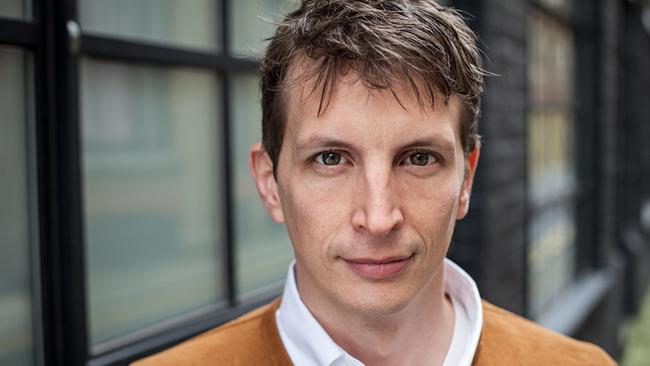Punk-age New York is Hallberg’s City on Fire but where’s the punk?
Garth Risk Hallberg dives into the moshpit of 1970s New York in his much-anticipated new novel.

Garth Risk Hallberg’s much-ballyhooed City on Fire, a 927-page epic that takes as its canvas New York City in the mid-1970s, at whose heart lies an ambivalent celebration of the radical shifts in that historical moment, is the opposite of punk. Punk was angry, ugly, fragmentary, off the cuff; Hallberg’s novel is thoughtful, elegant, encyclopedically researched and impeccably wrought. Punk was homemade in aesthetic terms, leery of satisfying any audience, anarchic in its politics; City on Fire is Jamesian in its artistic scope and intellectual aspirations, and whatever its gestures towards the theorists and artists who provided punk with a rudimentary intellectual substructure, it submits to the middlebrow obligation of engaging a wide potential readership.
Yet it is every bit the work we have been told to expect. Surely few more ambitious and acute literary sociologists have appeared on the American scene since Joan Didion, Tom Wolfe and their generational cohort of New Journalists. And as story pure and simple, its broad vision of New York life approaches that of Atticus Lish’s deservedly lauded Preparations for the Next Life, published six months ago.
Hallberg is a writer in full command of his material and his manner — just not in his ability to boil it down to some final, Tolstoyan synthesis of world and art.
Then again, Tolstoy never needed to bother himself with the music of Iggy and the Stooges, the fictions of Kathy Acker, Penny Rimbaud’s graphic designs and Vivienne Westwood’s anti-fashions — the whole dark gnosis of the punk movement. Hallberg has been obliged to use a relatively staid literary form to incorporate what novelist William Gibson once called ‘‘the detonation of some slow-fused projectile buried deep in society’s flank’’: punk, an essentially violent, de-creative effort contained within a considered creative structure. The marvel is not that he manages to do it well, but that he manages to do it at all.
Hallberg, who is only 36 and a relatively new arrival to New York from South Carolina, manages this paradox by spreading his bets. Though the novel is centrally concerned with the brief career and mysterious fate of a punk rocker known as Billy Three Sticks, whose band, Post Ipso Facto, produced just one rough-hewn album (City on Fire is the LP’s title) in 1974 before breaking up, the character has more grounded origins. He is the son and heir of one of the richest families in the city, the Hamilton-Sweeneys — or at least was, before his unbusinesslike creative talents, his homosexuality and weakness for booze and then drugs led him to escape the domestic hearth for the arson-riddled, crime-plagued downtown.
The sad, savage and wondrous life of William Hamilton-Sweeney III — his passage from teenage rebel to countercultural legend — provides the golden thread for a narrative that can seem impossibly disparate in terms of cast and chronological sweep. It allows Hallberg to tie a group of mohawked anarchists known as the Post Humanists in 1977 to some of the 19th-century founders of American capitalism; and it permits the scion of an immense fortune to mix with a number of ordinary American individuals, men and women whose lives critique, challenge or exult William’s various selves.
These include mild, bookish Mercer Goodman, African-American son of risen Georgia sharecroppers and brother to a damaged Vietnam veteran, who comes to Manhattan to teach at an upscale girls school and write the great American novel but instead becomes Billy’s lover, nurse and would-be saviour. And then there is Samantha Cicciaro, a child of the middlingly prosperous outer boroughs who reverses the current of her immigrant family’s suburban striving in favour of the city and its emerging moment. It will be Sam’s shooting in Central Park on the stroke of midnight at the end of America’s bicentennial year that makes the numerous characters sketched out by Hallberg suddenly glow in constellation.
There is, it should be said, a swallowing-the-tale aspect to all this happenstance. Mercer is first to find the girl after the shooting. He has no way of knowing that Sam is the lover of one of Billy’s former bandmates. And there he is, in a borrowed tux, just come from a party at the Hamilton-Sweeneys where he has bonded with Regan, long-estranged sister to William/Billy and wife of Keith Lamplighter, a handsome all-American type who has also had dealings with the Cicciaro girl.
So: a whodunit that drags into its gravitational field people from various races and classes, religions and political positions, ages and sexual persuasions — multiple personalities and perspectives on events converging on and exploding out from a single violent act, itself occurring at the heart of a city which for many has reached its economic and social nadir, though for others has arrived at its best, most intoxicating moment.
If the set-up sounds contrived, that sense is forgiven by the sweat and blood spent by the author in making his creations live on the page. Whether it is Jenny, the middle-class Maoist, uneasy child of Vietnamese immigrants, or Bruno, the imperturbable Holocaust survivor art dealer, or Charlie, a redheaded Jewish teen who turns to the New Testament and Post Ipso Facto for meaning, Hallberg gives his all in instilling some distinct experience and quality of selfhood to each. He works on the immense canvas of City on Fire with the mimetic relish of a Mexican muralist.
That all this is great fun hardly needs to be said: the more uneasy parts, the queasy metaphysics of urban blight and political decline, are generated out of the nervy, hard-boiled language with which the tale is clothed. Hallberg is not a born stylist — you do not read him for the next thrilling sentence, the whipcrack apercu — but there is a sincere and intelligent grafting of registers in his prose: wised-up contemporary command of idiolect, and a melancholy formal mode. He writes like Billy Three Sticks talks: a creature of two worlds, constantly code-switching according to whether his interlocutor is a Hells Angel or a debutante.
The difficulty of City on Fire emerges from this same mix of registers. Hallberg, to his immense credit, has produced a novel of uncommon ambition that lives up to its billing as a bestseller with literary credentials. Yet to do so he has had to give up on the forbidding demands of the novel after modernism: to rewire our sense of self and world, to refuse the easy blandishments of narrative closure, to submit the reader to the same kind of hard aesthetic graft that links the fiction of Thomas Mann with the lyrics of Patti Smith.
There is nothing ignoble about writing to charm, engage and excite readers; but there is something troubling about a novel that borrows its power from a historical moment of considerable creative energy, which gains its credibility in part by decrying the appropriation and exploitation of that cultural moment by the ineluctable forces of capital (and whose hymning of the loss of an older, dirtier and more vital New York is an essential aspect of its virtue), yet is everywhere sold on the strength of its $US2 million advance and a film already in the works.
This is mostly the decision of the publishers, sensibly trying to regain that advance, not Hallberg. He embeds disquiet regarding the ways in which the raw culture through which his men and women move is already being mythologised and commodified in the novel’s pages. Yet acknowledging this does not extricate the author from the process he critiques.
Punk, that final spasm of 19th-century romanticism, is nothing without its underlying politics, its earnest absolutism. You can’t be half punk, any more than you can be half pregnant. Anything else is genre, cleverly marketed noise.
Geordie Williamson is The Australian’s chief literary critic.
City on Fire
By Garth Risk Hallberg
Jonathan Cape, 927pp, $32.99



